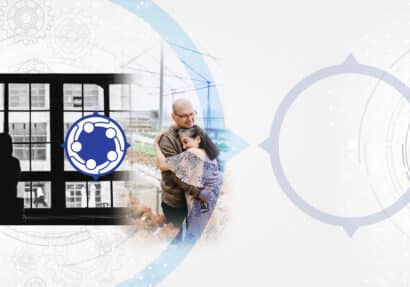In addition to providing digital strategy to businesses and nonprofits, CHF Educational Director Daniel DiGriz has nearly 30 years of global instructional experience and holds an M. Ed. in instructional design and technology. In a recent interview with CHF Editorial Director Sofia Perez, Daniel explained the principles and philosophy that underpin The Foundation’s educational initiatives, which have been designed to serve our audience of working artists.
SP: Let’s start with the big picture. Why has CHF’s educational program developed as it has?
DD: Traditionally, the way children have been taught is as though they were a tabula rasa, a blank slate. The view is that they’re coming in as impressionable flowers, ready to be shaped, but the truth is that they already have pre-existing notions and learning, no matter how early you get them. Learning occurs in the womb.
Well, adults come in with an even more developed context. There are three basic hallmarks of adult education. You fight these hallmarks at the expense of your education being ineffective.
The first hallmark: Adults don’t respond well to didactic learning. They want interactive learning. They want to be involved, because this acknowledges that they have a certain amount of life experience, which allows them to integrate what they’re learning into what they already know. If you take a kid who doesn’t know anything about math, you can start from the top and teach them whatever you want about math. If you take an adult who is using math everyday and you try to teach them math in that same way, it’s not going to be successful. They need to integrate the knowledge you’re providing into the working knowledge they already have. So, hallmark number one of our program is that it is interactive learning.
“…When you were in grade school, you took Social Studies 101 because you had to. You didn’t have a choice. Adult learners want to set their own objectives. They know why they’re taking a course. The working artists in our program have all the earmarks—on steroids—of adult learners. They’re not adults who’ve been on a desert island; they’ve been making a living...”
Hallmark number two is that adults don’t JUST have existing experience—they have existing expertise. The combined expertise of the learners in any given session or track is greater, in most cases, than that of the instructor. In other words, if you have ten students and each of them has been a working artist for five years, that’s 50 years of combined experience, versus an instructor who’s been a working artist for maybe 20 years. It doesn’t automatically mean that those years make the group smarter, but it does mean that you must acknowledge and involve that expertise in the learning process.
Adult learning has to be designed in such a way that we’re solving real problems adults have, and that we’re acknowledging their existing talent and expertise. They will know things that the instructor will not, and you have to be comfortable with that.
The third hallmark of adult education is that it needs to be designed for social learning in small groups, and this is really the secret of why CHF’s program works.
Organizations continue to design programs that are shaped around a very traditional and obsolete model of education that was developed for small children. Imagine classes of 20, all facing forward, interacting only or mainly with the instructor and, in fact, forbidden to collaborate with each other in knowledge-building and sharing. That it isn’t even effective for most children anymore, and probably never was. Decades of research and accumulated experience tell us that adults, in particular, learn better in a small-group context, and they learn better when they can engage in social learning.
Regardless of the number of participants in our program, we limit session size to ten. Then, we foster project groups of four or five. It’s difficult to collaborate with a stadium of people. The idea behind social learning is that you get everyone together in an actual or virtual room, and you brainstorm and develop solutions together. You test those solutions together. You compare results with one another. You compete, on some level. And you draw conclusions not in a vacuum, but out of a marketplace of possible conclusions.
SP: Our program also employs informal learning and interactive media. Explain the importance of those elements.
 DD: When you were in grade school, you took Social Studies 101 because you had to, because everybody was taking it. You didn’t have a choice. You studied English because somebody made you. Adult learning is inherently voluntary learning. Adult learners want to set their own objectives. They know why they’re taking a course.
DD: When you were in grade school, you took Social Studies 101 because you had to, because everybody was taking it. You didn’t have a choice. You studied English because somebody made you. Adult learning is inherently voluntary learning. Adult learners want to set their own objectives. They know why they’re taking a course.
Adults are already members of social groups. When you want information about solving a legal issue, for example, the first person you ask may not necessarily be a lawyer. Very often, it’s two or three friends. “Hey, do you think I should get a lawyer? Have you done this?” Adults do not primarily develop their knowledge through school, and they don’t always start with an appeal to experts. Mostly, adult learning starts and is developed within their existing social networks, through collaborative information-sharing.
Informal learning is a component of adult education. It says, “We know you come with your own objectives.” Sure, we help shape those objectives—it’s a collaborative process—and we assign mentors to help do that, but we don’t dictate. Informal learning means that you’re going to acquire skills in multiple ways. Sometimes, it’s by asking questions. Sometimes, it’s through observing experts. Sometimes, it’s practicing the skill in a lab environment or conversing about the skill. It’s the kind of natural learning that human beings, especially adults, do outside of a classroom. A successful learning environment should be structured to mirror the non-structured learning environment in which adults actually learn.
This is why our program is interactive and uses interactive media. The working artists in our program are adult learners who have all the earmarks—on steroids—of adult learners. They’re not adults who’ve been on a desert island; they’ve been making a living.
SP: Let’s talk specifically about how our program delivers its content to working artists.
“…Asynchronous learning means you can learn at a time that’s convenient for you. We do this on purpose, because it’s ideal for working artists. You can’t learn if you’re in the middle of a show. You certainly shouldn’t destroy your studio time. You can’t drop everything to go to class. But you do need to devote time to [learning business skills]…”
DD: Well, it depends on whether we’re talking about CHF’s public education work—our Learning Portal—or the Business Accelerator Program, which is much more focused. And by the way, it is very common for successful educational programs to have different tracks like this; it isn’t a marketing scheme to give people a taste and get them to join the larger program.
The public side is built around the principle of self-instruction, which is not a frivolous term; it is the primary way adults learn. They reach out to their networks. They interact and collaborate with small groups. They learn informally by observing others. They do it in an interactive way. They ask questions that are unplanned. We’re not spoon-feeding. They are self-driven learners, so our public education is built around the notion of self-instruction. Another way of framing it is asynchronous learning.
Our mission is to equip working artists to become thriving artists, and education is central to that mission. We want to empower artists, and you don’t empower them if you overly structure every offering you make. You put out a set of tools, and let them choose. Our public education does that, while our accelerator program is necessarily a bit more structured and rigorous on pace, outcomes, and selection of curriculum.
SP: Explain asynchronous learning in a little more detail.
DD: It means you’re not face-to-face with us, starting to learn at exactly 3:00pm and ending at 3:50pm. Asynchronous learning means you can learn at a time that’s convenient for you. We do this on purpose, because it’s ideal for working artists. You can’t learn if you’re in the middle of a show. You certainly shouldn’t destroy your studio time. You can’t drop everything to go to class. But you do need to devote time to this.
Some people call it self-paced learning, but the asynchronous aspect of that is key. It means being able to learn at times that fit your work schedule, from anywhere you can connect, without having to commute—even to the point of learning from your own studio, with paint still on your hands.
An asynchronous program mirrors the community-education courses that many universities offer to working adults. They often use a multimedia methodology and remote learning because it’s easier to accommodate people that way. By the time you spend an hour driving to a classroom and 20 minutes to find parking, then retrieve your car at the end and get back home, plus time spent waiting for class to start and dealing with set-up, etc.—that’s three hours. You could have gone to two virtual classes by then, which is why I did my entire Master’s Degree through distance learning, without even one hour of physical time in a brick-and-mortar class environment. I already had a career. I wasn’t looking to start over at the beginning—I was looking for practical tools in that learning so that I could move ahead.
With asynchronous learning, YOU set the pace. Everyone is different. We can’t enforce a pace, because the artists in our program need to learn on their own schedule. They choose their own path, because they have their own objectives. Maybe they want to focus on marketing and the financial side. Or maybe it’s sales and logistics, like how they track their work. It’s up to them, and where they feel they need the most help to go from merely working to actually thriving. They can also review and repeat that material as needed.
Self-instruction is often viewed as not being individualized enough, but it IS very individualized in an adult learning context, because adults are individually motivated. Unlike small children, adults already know what they want to learn.
We’re not a one trick pony, though. Our Business Accelerator Program utilizes both synchronous and asynchronous education—fixed workshop and lab times, and self-scheduled components. It’s both collaborative and self-directed. It’s really the gem of our overall educational initiatives.
There’s also a third initiative we’re working on. While we offer distance education, in both the public and accelerator programs, we are also planning boots-on-the-ground learning events. We’ve already done some of that stuff in the form of panel discussions, but that’s not the end game. We want to offer actual face-to-face instruction to complement our distance instruction. It won’t become all we do, because sure, you can watch the video later, but you can’t be at the event later. You don’t get to ask your question later because the event is happening now. But it’s a part of our overall mission, certainly.
So our public education efforts are not at all ignoring synchronous learning, but we want to develop all of our learning by distance learning first, because we can deliver maximum burn that way; it helps us reach the widest variety of people. We can put out the tools they need now, and then offer boots-on-the-ground instruction in the future, as a way to delve even deeper.
SP: And what’s the philosophy behind CHF’s Learning Portal?
DD: We created it to offer true multimedia; the learning is in multiple formats, including our podcast courses. But they don’t feel like courses; they feel like the media we already consume every day. As adults, we listen to podcasts. We read books and newspapers. We already do things on our own that are self-directed and self-motivated. CHF is not looking to create a special type of medium called the “virtual class.”
When’s the last time you had a little time left over after work and said, “I think I’ll take a class!” We’re using media that people are already familiar with and can access on their phones, with their earphones at the gym, in their car, or even on their TV smart device. Making it about the transmission of expertise, instead of a formal classroom environment, also helps us get a variety of industry and professional talent into our pipeline, so that people can receive a lot of different perspectives and expertise.
We have a learning portal with multiple formats—podcasts, event videos, interview columns, and other things—and the information is served up as content-on-demand. That means you can easily find what you need to learn. You can locate financial knowledge, legal information, sales and marketing knowledge. It’s also continually expanding, because the curriculum is open-ended and exploratory.
We also provide reusable learning. That means there’s a video or article that you can refer back to, with a link or share button for social media. You can share it with somebody else. It’s not, “You have to be in class or you missed it.” We’re not knocking that type of education, but if that’s all there is, the education becomes disposable, not reusable. And we’re reusing the educational content as well—meaning that if we do have a boots-on-the-ground educational event, we’re filming it, and cutting it up into usable segments, and we’re also expanding on some of the multimedia material in-person. So it’s not just, “Oh, here’s a three-hour film of our panel discussion.”
SP: And on the Business Accelerator Program side?
DD: Our Business Accelerator Program for working artists is much more concentrated, and we use a blended learning model. Blended learning draws from the best of both synchronous and asynchronous education. We do that in the form of live workshops and labs combined with access to a library of those classes, group interaction, individualized projects, small-group project-management assistance, and one-on-one mentoring—and that’s in addition to providing access to the same public instruction everyone else has. All of those elements create a blended learning environment that adult working artists find very suitable to fit into their busy working lives and the ways they already learn.
There’s another self-directed element, in the sense that the artists in our program, our fellowship recipients, actually shape the course. Not just in their feedback after the fact, but they actually dictate questions for future instructors to answer, or problems or challenges that can be solved in a kind of virtual lab. A virtual classroom is like a traditional classroom, but you enter it digitally. A virtual lab is a spinoff of the virtual classroom, except it’s much more interactive. You get to shape the course content. No two are the same. It’s truly a cutting-edge learning program for working artists.
SP: Plus, our program was developed in conjunction with artists.
DD: That’s right. Our mission is not a paternalistic one. We’re not here to figure out what artists are missing and tell them. We didn’t just build this program on our own; working artists have contributed heavily to the construction of it, and they contribute to its ongoing development.
We had phone call after phone call with artists, and we listened to what they had to say. Things like, “I feel held hostage by my gallery.” “I am unable to scale my business past a certain point.” “I can’t focus on growth, because I’m spending all my time in my studio.” “I want to focus on growth, but I don’t know where to start.” We documented what they had to say about the struggles they face in being financially successful, in contributing to the economy, and in attaining financial independence. We built it from the bottom up, not the top down. That was really important to us.
And our educational program was also created in conjunction with the ideas and ethos espoused by Clark Hulings during his lifetime. He was immensely creative and technically brilliant, yet he was also a person who treated his art as a business. He didn’t sacrifice his artistic vision to do that. He never stopped creating or learning, and he also never stopped working on his business. That’s the trifecta.
In fact, it’s precisely because he actively ran his own business that he was able to be more successful, have more reach, be more economically viable, contribute to the economy, and develop his skill set. He didn’t rely on some ancient notion of patronage. The best way for a working artist to pursue a creative vision is to achieve financial independence through the sale of his/her work.
SP: Some folks know you as the host of our Thriving Artist Podcast, and others as our in-house marketing expert, but tell us about your experience in the educational field, because it’s quite extensive.
“…[At CHF], we’re committed to a business focus—to providing the skills that will help artists grow their businesses. We’re committed to sound adult education. And we’re committed to metrics that demonstrate actual impact. It’s hard to find that combination elsewhere…”
DD: I have Master of Education degree in instructional technology, which is a full-on education degree and a focus on instructional design, specifically digital, web-based, and multimedia education. Essentially, I can utilize knowledge of educational psychology to design a complete educational program, from a school to a postgraduate program to a bootcamp. I also have a strong background in corporate training, including more than a decade doing that work in Fortune-500 environments, so that means much of my experience is in delivering business education specifically and adult education in particular.
I was an educator before that. I taught overseas. I filled in at public schools. I worked one-on-one with at-risk students. All of those situations helped me develop experience and perspective on the crucible of challenges that people face. I never worked anywhere, for any length of time, where learning was smooth going. Never “take this knowledge, score this on the SAT, go on to Yale, and enjoy your life in Connecticut”—no, that was never the environment I was in. In corporate life, it was always change management in the midst of an overhaul of the company model or entire processes being shifted and overthrown. I was always working with people who needed to learn in order to grow with a company or overcome the hurdles in their lives. That’s why my focus is all about equipping people to be independent, and usually on the cusp of some cultural change.
That said, I’m not the center of the program. I’m just one of its stewards. Another steward, of course, is Elizabeth Hulings, who as a business strategist and the daughter of Clark Hulings, is the main visionary. You’ve obviously interviewed her far more frequently, and for good reason.
SP: Any beyond your credentials and hers, why do you think CHF is uniquely qualified and positioned to provide this kind of education to working artists?
DD: We draw upon an extensive talent pool of industry and business experts. This is a non-elitist program. We are not focusing on artists who are the art industry’s flavor of the week. We’re not trying to produce a single one-in-a-million success. We’re working with art-world leaders, business experts, and successful working artists who have a lot of creative juice in their art and a lot of experience.
Our business focus is the lion’s share of it. We’re not focused on a person’s practice or artistic technique. Those things are important—we’re not denying that—but there are plenty of other schools and ateliers and organizations that focus on that. Right now, in the art world there’s a real dearth of business training that helps artists to be viable—even the most basic training that any MBA student would get, on how to construct a viable business. That training doesn’t guarantee success, but if you take it away, it guarantees their incompetence to run a business. At the very least, artists deserve to have the toolset that’s necessary to help them be economically viable. And of course, we want to go beyond viability; we want to do our job so well that the artists in our program thrive.
We want to fill the world with art, and doing that requires working artists to have the kind of business training, acumen, and network support that an MBA gets. We’re producing artist-CEOs in charge of their own destinies. They’re doing the work. They’ve built their ships, and these are already afloat; now we’re teaching them how to keep the wind in their sails. That’s one reason we named it the “accelerator” program.
SP: And we’re talking about achieving real and measurable progress.
DD: Yes, we’re committed to data science. We’ve built this thing from the ground up to produce a measurable return on investment—to move the needle in a demonstrable way. Of course, we’re committed to the people involved, but we are asking our individual learners to commit to milestones that shape their career and put some key performance indicators on those milestones. We are measuring their progress in conjunction with the program, and gathering critical data that further informs, refines, and accelerates the accelerator program itself.
We just got through doing a significant piece of statistical research that tells us what artists’ values are and what they view as their greatest educational needs. You can’t synthesize a program out of that, unless you know both of those things. We have plenty of insights about who we’re talking to and who the market is. I like that data is objective; it lets us and working artists make objective decisions.
SP: So when folks ask, “Why CHF?”, the answer is that we have all of the puzzle pieces at our disposal.
DD: Exactly. Number one: We’re committed to a business focus—to providing the skills that will help artists grow their businesses. Number two: We’re committed to sound adult education. And number three: We’re committed to metrics that demonstrate actual impact on the world. It’s hard to find that combination elsewhere.
And the other answer to that question is, “If not us, then who?” We have the tools. We have the people. We have the vision. And we have the commitment.








Very insightful. I will apply to this. I have been thinking of getting an MFA after I heard an interview with an artist that is able to self-support from their art creation. That artist explained the MFA program helped them learn how to speak about their art to people in a way that collectors understood art is made for them to be able to collect it, and that that artist’s work and all work is made for a target audience. I am missing this. I was thinking to do an MBA but feared I would have time taken out of my already good productive discipline studio working time without the program understanding a student comes with the Artist point of view. I have many pieces from so many online courses for an art business except what it seems the Clark Hulings Accelerator has.